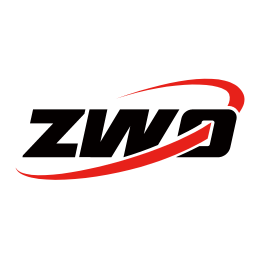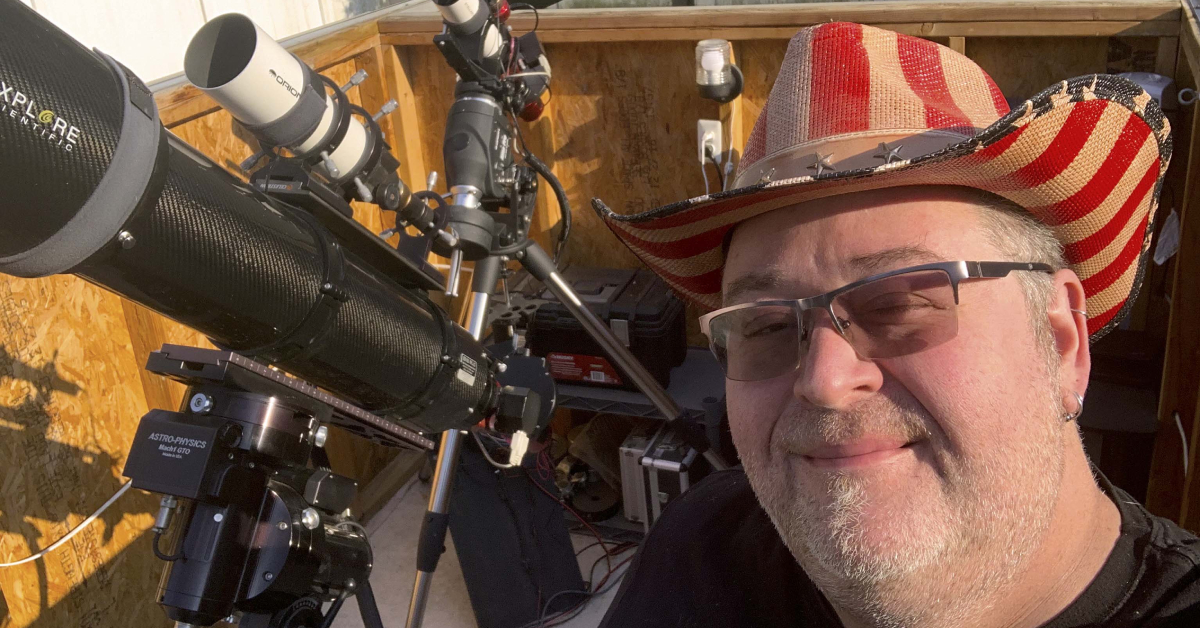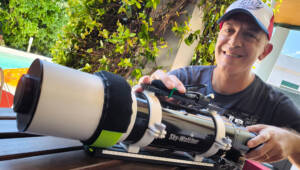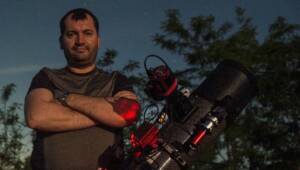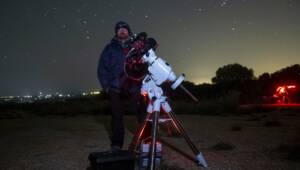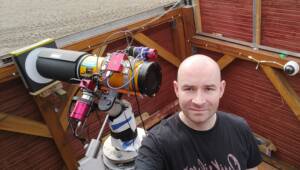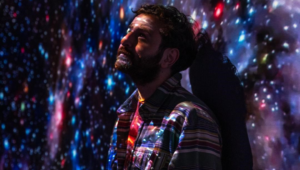Q1: At first, congratulations that your nice image won #ASIWEEK. Can you introduce yourself to us?
My name is Douglas Struble. I live in Michigan 15 minutes from Detroit in the United States with a Bortle Sky Scale of 8 making it very hard to do astrophotography with the light pollution. I own an advertising production company called Future World Media.

Q2: Why do you love astronomy? How did you start astrophotography?
I have loved astronomy all my life. When I was a teenager, I used to write astronauts a lot including Neil Armstrong, Buzz Aldrin and Michael Collins. Their three autographed photos are framed in my studio to this day along with John Glen. While I have loved photography all my life and doing media production, it wasn’t until I got older that I was able to do astrophotography in a way that required a serious investment. My uncle Robert Nagy originally got me interested in astronomy when I was young with his 8” Celestron SCT. I have always loved science and the arts; both are required to be a good astrophotographer in my opinion.

Q3: What gear do you have? Any pictures of them?
I started doing astrophotography in 2016. In 2017 I designed and built an 8’x10’ slide off roof observatory. Inside houses a permanent pier with an Astro-Physics Mach1 mount and my Explore Scientific 165mm APO. I have a second rig with an Orion Atlas Pro mount that I utilize two Stellarvue telescopes; one is a 102mm APO and the other is the SV70T. I run both rigs at the same time focusing on two different targets with a Windows laptop running each rig that is controlled in my house from a Mac Pro. Both rigs use a ZWO ASI1600MM with a mixture of Astronomiks and Astrodon Broadband and Narrowband filters.


Q4: How is the air quality in your region?
My skies here in Michigan are generally pretty bad along with the light pollution living just outside of Detroit. While I am able to do some broadband imaging with a tremendous amount of integration time, I try to mostly go after narrowband targets here in my backyard in my slide off observatory. With the focal length of my 165mm APO, I can go after a lot of planetary nebula in Ha and OIII and resolve detail pretty good down to 1 to 0.5 arc minutes with a lot of heavy processing.

M57 in HaOIIILRGB. Equipment: Explore Scientific ED165CF FPL-53 + Explore Scientific 152 mm Carbon Fiber + ZWO ASI1600MM Cool + ZWO ASI1600MM Pro + Astro-Physics Mach 1 GTO. Integration: 30.5 hours.
Q5: How did you capture your winning picture Sh2-96? Was the whole project rather smooth?
Sh2-96 is a giant super nova remnant that is rarely attempted. No signal was visible in a single sub. The whole nebula is so enormous that only a portion of it was captured even with the short focal length of my Stellarvue SV70T. I went after the most prominent portion in this case. With almost 40 hours of integration time in SHO, I got IOTD on Astrobin. I reprocessed it in HOO, which I got image of the week with ZWO. I had to remove the stars to really push the nebulosity and then add them back in.

Sh2-96. Equipment: Stellarvue SV70T + ZWO ASI1600MM Cool + Orion Atlas Pro AZ/EQ-G. Integration: 25.9 hours.
Q6: What post-processing software do you use? People say the processing is one of the most difficult parts of astrophotography – what do you think?
While integration time is crucial especially in a heavily light polluted area, processing is a very daunting task to push the data even further. I use PixInsight and Photoshop CC. Once I get the stars out the way, it makes it a bit easier to push the data. There really is no magic bullet; it is a little bit here and a little bit there to really process it right.

WR 134 in HOO. Equipment: Explore Scientific 152 mm Carbon Fiber + ZWO ASI1600MM Pro + Astro-Physics Mach 1 GTO. Integration: 19.1 hours.
Q7: How do you keep awake at those busy nights of imaging?
This is the easy part. My observatory is fully automated. On a good night with no intermittent clouds, I can just let it go all night on it’s own. While it is going, I often work on my actual work; putting together advertising commercials. If the night is good, I’ll just go to sleep and let the two rigs run all night. I have to keep tabs on the forecast and satellite to make sure there is no rain or snow coming, though.

Q8: What changes and surprises do you think astrophotography has brought you over these years?
While I have only been doing serious astrophotography since 2016, I have interested in it and read up on it for many years. With the bortle sky scale of 8 and my horrible skies, there would be no way I could ever do astrophotography with traditional film. My cameras flood easily with light pollution and have to keep my exposures short; around 60 seconds for broadband at zero gain and 2 minutes for narrowband with 200 gain. Because of this, I have to capture a lot of subs that eat up a lot of hard drive space to get my signal to rise above the noise. This has taught me a lot of patience. If I were in darker skies, I could get away with less overall integration time. However, I have to really pile on the data with a ton of integration time to bring out the signal necessary. Patience is crucial where I am located.

Headphone Nebula in HOO. Equipment: Explore Scientific 152 mm Carbon Fiber + ZWO ASI1600MM Pro + Astro-Physics Mach 1 GTO. Integration: 36.0 hours.
Q9: We know 2020 is a very special year. Do the things happened this year affect you and the ways how you do astrophotography?
My biggest upgrade to making this hobby easier and more convenient is designing and building my slide off roof observatory. For example, I may only get in a couple hours in a night before clouds roll in. If I was having to set up and tear down two rigs, I might not even bother setting up. Building my observatory has allowed me to squeeze in a couple hours here and there over several nights during the winter bad months.
Q10: What achievements have you made on astrophotography during the year 2020?
I am featured any several magazines including Sky & Telescope, Astronomy and The BBC Sky at Night on a regular basis along with Top Picks and Image of the Day on Astrobin. My main goal these days is to concentrate on rare targets and pull a lot more detail out than others have. Sometimes I take a break and work on easier targets, though.


Q11: How do you think about the future development of astrophotography?
Astrophotography is constantly evolving. I think it will become more affordable down the road for many bringing more people into the fold. Personally my challenge is the quality of my skies and the pixel scale I can hope for. That seems to be limited for the time being. My Explore Scientific 165mm, my main scope, is at 0.68”/pixel with my ZWO ASI1600MM. I would love to try a ASI183MM on it, but I am afraid my pixel scale may be too low with my skies.

Sh2-112. Equipment: Explore Scientific ED165CF FPL-53 + ZWO ASI1600MM Pro + Astro-Physics Mach 1 GTO. Integration: 19.0 hours.
Q12: How many ZWO products do you have, what’s your first ASI camera?
My first ZWO camera was an ASI120MC doing planetary work back in 2016. Since then I have bought and still use an ASI1600MM Pro and an ASI1600MM Cooled for both my rigs.

Sh2-68. Equipment: Stellarvue SVX102T-R + ZWO ASI1600MM Cool + Orion Atlas Pro AZ/EQ-G. Integration: 36.4 hours.
Q13: Which ASI camera has a special place in your heart?
Without a doubt, my two ASI1600MM cameras have served me well. I have an older ASI1600MM Cooled on my smaller rig and an ASI1600MM Pro on my primary rig. Both cameras have served me very well and are very stable to the point where I only do a new set of darks and bias about twice a year. Here is a link to my Astrobin page with all my astrophotography:
https://www.astrobin.com/users/dugstruble/

MWP1 & ALV1. Equipment: Stellarvue SVX102T-R + Explore Scientific 152 mm Carbon Fiber + ZWO ASI1600MM Cool + ASI1600MM Pro + Astro-Physics Mach 1 GTO + Orion Atlas Pro AZ/EQ-G. Integration: 50.2 hours.
Q14: What feedback or suggestions do you have for ZWO?
While I know the ASI183MM is more suited for shorter focal lengths, I would like to see a mono camera more suited for longer focal lengths like my 165mm APO bringing me down to about 0.50”/pixel.
Q15: What plans do you have for the year 2021?
For 2021 I would like to invest in a third rig that would be of a focal length of around 100mm to 200mm. This would also make for a very good portable system for when I travel to northern Michigan. On my primary rig, the ES 165mm with a focal length of 1155mm, I would like to continue capturing smaller planetary nebula and Sharpless (SH2) objects. These are a love of mine. I wrote an article on planetary nebula for Explore Scientific back in 2019:
https://explorescientificusa.com/blogs/explorescientific/strubles-planetary-cosmos

